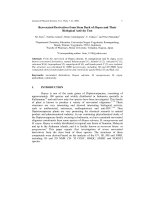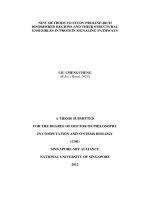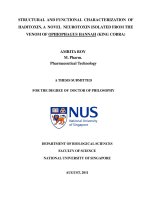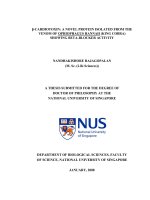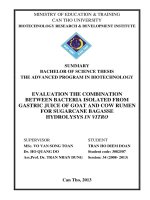New stilbenoids isolated from fungus challenged peanut seeds and their bioactivity evaluations
Bạn đang xem bản rút gọn của tài liệu. Xem và tải ngay bản đầy đủ của tài liệu tại đây (5.51 MB, 228 trang )
NEW STILBENOIDS ISOLATED FROM
FUNGUS-CHALLENGED PEANUT SEEDS
AND THEIR BIOACTIVITY EVALUATION
LIU ZHONGWEI
NATIONAL UNIVERSITY OF SINGAPORE
2013
NEW STILBENOIDS ISOLATED FROM
FUNGUS-CHALLENGED PEANUT SEEDS
AND THEIR BIOACTIVITY EVALUATION
LIU ZHONGWEI
B.Agr.China Agricultural University
M.Agr.China Agricultural University
A THESIS SUBMITTED
FOR THE DEGREE OF DOCTOR OF PHILOSOPHY
DEPARTMENT OF CHEMISTRY
NATIONAL UNIVERSITY OF SINGAPORE
2013
Declaration Page
I hereby declare that this thesis is my original work and it has been written by me in
its entirety, under the supervision of Associate Professor Huang Dejian, (in the
laboratory S13-level 5), Chemistry Department, National University of Singapore,
between Jan 2009 and Jan 2013.
I have duly acknowledged all the sources of information which have been used in the
thesis.
This thesis has also not been submitted for any degree in any university previously.
The content of the thesis has been partly published in:
1) Liu, Z.W., Wu, J.E., Huang, D.J., 2013. New arahypins isolated from
fungal-challenged peanut seeds and their glucose uptake-stimulatory activity in
3T3-L1 adipocytes. Phytochem. Lett. 6, 123-127.
2) Liu, Z.W., Wu, J.E., Huang, D.J., 2013. New stilbenoids isolated from
fungus-challenged black skin peanut seeds and their adipogenesis inhibitory activity
in 3T3-L1 cells. J. Agric. Food Chem. 61, 4155-4161.
3) Liu, Z.W., Yan, Y., Wang, S.H., Ong, W.Y., Huang, D.J., 2013. Assaying
myeloperoxidase inhibitors and hypochlorous acid scavengers in HL60 cell line using
quantum dots as the luminescent probe. Am. J. Biomed. Sci. 5, 140-153.
4) Yan, Y., Wang, S.H., Liu, Z.W., Wang, H.Y., Huang, D.J., 2010. The CdSe-ZnS
Quantum Dots for selective and sensitive detection and quantification of hypochlorite.
Anal. Chem. 82, 9775-9978.
Liu Zhongwei
Liu Zhongwei
July 23 2013
Name
Signature
Date
I
Acknowledgements
First and foremost, I wish to express my utmost gratitude to my supervisor Prof.
Huang Dejian for his insightful advice, valuable guidance, and consistent
encouragement given throughout my PhD candidature. I feel honored to have him as
my supervisor and benefit greatly from his profound knowledge in food chemistry,
strict requirements for experiment design, and inspiring discussions on my research
project. Without his strong support, I cannot complete my research project and PhD
thesis. I am also deeply grateful for his great help in my access to various research
resources and technique assistance from other labs and academic staffs.
Next, I would like to express my special thanks to Dr. Wu Ji‟en for his crucial help in
the acquisition of 2D NMR spectra, structure elucidations, and data presentation in
manuscripts. Besides, his rich research experience in natural product chemistry had
significantly optimized my experiment plan and greatly accelerated my research
progress. Without his critical technique assistance, my research project after
qualification examination may be another scene. Here, I also want to express my
sincere gratitude to Dr. Wang Suhua who have helped my research project with his
high quality quantum dots. It is my great fortune to know these two warm-hearted
staffs with rich research experiences in their respective areas.
I am much indebted to Prof. Ong Wei Yi Who allowed me to learn the cell culture and
basic molecular biology techniques in his lab. His helpful and friendly students leave
me a very deep impression as well. My thanks also go out to Prof. Tan Kwon Huat for
II
his generosity in providing cell strains and resourceful suggestions on my research
projects. In addition, I give my sincere appreciation to Ms Lee Chooi Lan, Ms Jiang
Xiao hui, Ms Lew Huey Lee, and my lab colleagues Dr. Quek Yi Ling, Mr. Wu Ziyun,
Ms Chen wei, Ms Yan Yan et al. for their kind help and advice throughout my
research projects. I am also really grateful to NUS for research scholarship and
funding which finance me and my research project.
Last but not least, I would like to express my family style thanks to my parents who
have always supports me materially and spiritually throughout these years. Their love
and understanding is my greatest motivation to complete this thesis.
Liu Zhongwei
March 1
st
2013
III
Table of Contents
Page
Summary…………………………………………………………………………VIII
List of Tables………………………………………………………………………X
List of Figures…………………………………………………………………… XI
List of Abbreviations XIV
Chapter 1: Introduction…………………………………………………………… 1
Chapter 2: Literature review……………………………………………………… 4
2.1 Structures, sources, and bioavailability of natural stilbenes………………4
2.1.1 Structural classifications of natural stilbenes……………………… 4
2.1.2 Plant sources of natural stilbenes……………………………………5
2.1.3 Bioavailability of natural stilbenes………………………………….6
2.2 Bioactivities of natural stilbenoids…………………………………………8
2.2.1 The antioxidant and anti-inflammatory bioactivities of stilbenoids… 8
2.2.2 Assays for MPO inhibitors and HClO scavengers………………… 11
2.2.3 ROS sensing by QDs as the fluorescent probes…………………….12
2.2.4 The anti-diabetic bioactivity of stilbenoids………………………….14
2.2.5 The anti-obesity bioactivity of stilbenoids………………………… 16
2.3 Stilbenoids isolated from peanuts and their bioactivities………………….17
2.3.1 Stilbenoids isolated from peanuts………………………………… 17
2.3.2 Bioactivities of peanut stilbenoids………………………………… 20
2.4 Stilbene oligomers and their bioactivities…………………………………23
IV
Chapter 3 Fluorescent assay using Quantum Dots for screening of MPO
inhibitors and HClO scavengers………………………………………………… 26
3.1 Introduction………………………………………………………………26
3.2 Materials and methods………………………………………………… 27
3.2.1 Chemicals and materials……………………………………………27
3.2.2 Cell culture…………………………………………………………28
3.2.3 Confocal microscopy imaging…………………………………… 29
3.2.4 Effect of HClO on the intracellular QDs………………………… 29
3.2.5 Fluorescent microplate assay………………………………………33
3.2.6 Data analysis……………………………………………………….30
3.3 Results and discussions……………………………………………………31
3.3.1 Effective cellular uptake of QDs-poly-CO
2
-
……………………… 31
3.3.2 Quenching effect of HClO on QDs-poly-CO
2
-
………………………31
3.3.3 Quenching effect of PMA stimulated cells on QDs-poly-CO
2
-
…… 34
3.3.4 QD microplate assay for HClO scavengers and MPO inhibitors……36
3.3.5 Time course of QD fluorescence quenching……………………… 41
3.3.6 DCFH-DA microplate assay……………………………………… 44
3.3.7 APF microplate assay……………………………………………….48
3.3.8 Resveratrol as a MPO inhibitor…………………………………… 49
3.4 Conclusion………………………………………………………………….50
Chapter 4 New stilbenoids isolated from fungus-challenged India peanut seeds
and their structure elucidations 52
V
4.1 Introduction…………………………………………………………………52
4.2 Materials and methods………………………………………………………54
4.2.1 Materials………………………………………………………………54
4.2.2 Instruments…………………………………………………………… 55
4.2.3 Processing of India peanut seeds……………………………………….55
4.2.4 HPLC and LC-MS analysis…………………………………………….56
4.2.5 Extraction and isolation of new peanut stilbenoids…………………….57
4.2.6 Spectroscopic measurements of new peanut stilbenoids……………….58
4.3 Results and discussions………………………………………………………59
4.3.1 Profiles of stilbenoids production in stressed, unstressed and nonviable
peanut seeds………………………………………………………………… 59
4.3.2 Targeting new stilbenoids from fungal-challenged India peanut seeds 61
4.3.3Structural elucidations of the new peanut stilbenoids by NMR analysis.63
4.3.4 Proposed formation mechanisms of the new peanut stilbenoids……….69
4.4 Conclusion……………………………………………………………………71
Chapter 5 New stilbenoids isolated from fungus-challenged black skin peanut
seeds and their structure elucidations 72
5.1 Introduction………………………………………………………………………72
5.2 Materials and methods………………………………………………………… 73
5.2.1 Materials……………………………………………………………………74
5.2.2 Instruments…………………………………………………………………74
5.2.3 Processing of black skin peanut seeds…………………………………… 74
VI
5.2.4 Dynamic analysis of peanut stilbenoids production by HPLC and LC-MS 74
5.2.5 Extraction and isolation of new peanut stilbenoids……………………… 75
5.2.6 Spectroscopic measurements of new peanut stilbenoids………………… 76
5.3 Results and discussion ………………………………………………………… 76
5.3.1 Dynamics of stilbenoid production in fungal-stressed black skin peanut
seeds…………………………………………………………………… 76
5.3.2 Isolation of new and known stilbenoids from fungal-stressed peanut
seeds…………………………………………………………………….80
5.3.3 Structural elucidation of the new stilbenes……………………………….84
5.3.4 Proposed formation mechanisms of the new peanut stilbenoids………….87
5.4 Conclusion……………………………………………………………………… 91
Chapter 6 Evaluation of biological activity of peanut stilbenoids……………….92
6.1 Introduction………………………………………………………………………92
6.2 Materials and methods………………………………………………………… 94
6.2.1 Chemical and reagents…………………………………………………… 94
6.2.2 Cell cultures……………………………………………………………… 94
6.2.3 MPO inhibition assay………………………………………………………95
6.2.4 3T3-L1 adipocyte differentiation and glucose uptake assay………………95
6.2.5 3T3-L1 adipogenesis inhibition assay…………………………………… 96
6.2.6 Cell viability assay…………………………………………………………97
6.3 Results and discussion……………………………………………………………97
6.3.1 MPO inhibition activity of peanut stilbenoids…………………………… 98
VII
6.3.2 The glucose uptake stimulatory activity of peanut stilbenoids………… 101
6.3.3 The adipogenesis inhibitory activity of peanut stilbenoids………………103
6.3.4 The cytotoxicity of peanut stilbenoids……………………………………105
6.4 Conclusion………………………………………………………………………106
Chapter 7 General conclusions and future work ……………………………….108
7.1 General conclusions…………………………………………………………….108
7.2 Suggestions for future work……………………………………………………109
Reference………………………………………………………………………… 113
List of Publications and Presentations………………………………………… 140
Appendices…………………………………………………………………………141
A.1 LC-MS chromatogram of (A) fungi stressed India peanut pieces (B) unstressed
India peanut pieces (C) India peanut pieces without treatments………………… 142
A.2 LC-MS chromatogram and UV spectra of (A) SB-1; (B) arachidin-1; (C)
arachidin-3 in mobile phase……………………………………………………… 145
A.3 HR-MS of (A) arahypin-8; (B) arahypin-9; (C) arahypin-10; (D) MIP; (E)
arahypin-11; (F) arahypin-12……………………………………………………….147
A.4 1D and 2D NMR spectra of (A) arahypin-8………………………………… 153
A.5 1D and 2D NMR spectra of (B) arahypin-9……………………………………166
A.6 1D and 2D NMR spectra of (C) arahypin-10………………………………… 177
A.7 1D and 2D NMR specra of (D) arahypin-11………………………………… 184
A.8 1D and 2D NMR spectra of (E) arahypin-12………………………………… 194
A.9 1D and 2D NMR spectra of (F) MIP……………………………………… 203
VIII
Summary
The objective of this study was to isolate and characterize new and/or known peanut
stilbenoids and to evaluate their biological activities. Four new prenylated stilbene
dimers (arahypin-8, arahypin-9, arahypin-11, arahypin-12) of novel construction
patterns and two new stilbene derivatives arahypin-10 and MIP were isolated for the
first time from wounded India peanut seeds and Chinese black skin peanut seeds
challenged by a Rhizopus oligoporus strain, a food grade starter culture for soybean
fermentation in Southeast Asia. The structures of the six new stilbene compounds
were elucidated on the basis of HRESIMS, UV, 1D and 2D NMR spectroscopy and
the plausible mechanisms of their formations were also proposed. The antioxidant,
anti-diabetic, anti-obesity and anticancer effects of six new peanut stilbenoids
together with three known peanut stilbenoids (arachidin-1, arachidin-3, and SB-1) and
resveratrol were tested and compared in different cell based assays. In the antioxidant
assay, arachidin-1 displayed the highest inhibitory effect on the highly reactive
oxidative species (hROS) generated by myeloperoxidase (MPO) in HL60
differentiated cells, compared with resveratrol which was shown to be a potent MPO
inhibitor in another assay using quantum dots (QDs) fabricated for specific detection
of HClO. In the glucose uptake assay, arahypin-8, arahypin-9, and arahypin-10
exhibited insulin sensitizing activity by significantly increasing glucose uptake in
differentiated 3T3-L1 adipocytes. In the adipogenesis inhibition assay, arachidin-1
was found to suppress the differentiation of 3T3-L1 preadipocytes most effectively
among the 10 stilbenes tested while arahypin-11 and arahypin-12 exhibited a
significant cytotoxicity in 3T3-L1 preadipocytes in the MTT assay. The results of our
IX
study indicate that the fungus-stressed peanut seeds may become a new potential
source of natural pharmaceuticals.
X
List of Tables
Table 3.1 Comparison of the potency of MPO inhibitors and HClO
scavengers in inhibiting the QD fluorescence quenching
induced by PMA stimulation
Table 3.2 Comparison of the potency of MPO inhibitors and HClO
scavengers in inhibiting the QD fluorescence quenching
induced by H
2
O
2
addition
Table 3.3 Comparison of the potency of MPO inhibitors and HClO
scavengers in inhibiting the DCFH-DA fluorescence increase
induced by PMA stimulation and H
2
O
2
addition
Table 3.4 Reactivity Profiles of APF and DCFH-DA
Table 4.1 NMR data of arahypin-8 (1)
Table 4.2 NMR data of arahypin-9 (2)
Table 4.3 NMR data of arahypin-10 (3)
Table 5.1 NMR data of arahypin-11 (1) and arahypin-12 (2)
Table 5.2 NMR data of MIP (3)
Table 6.1 Reactivity Profiles of APF and HPF
XI
List of Figures
Figure 2.1 General skeletons of common stilbenoids
Figure 2.2 Schematic representation of the MPO–H
2
O
2
system and its
products.
Figure 2.3 Monomeric stilbenes containing arylbenzofuran moiety
Figure 2.4 Proposed biosynthetic pathway of stilbenoids in peanuts
catalyzed by series enzymes
Figure 2.5 Structures of stilbenoids found in peanut tissues/organs
Figure 2.6 Structures of stilbenoids found in fungus-challenged peanut
seeds
Figure 2.7 Structures of arahypin-6 and arahypin-7.
Figure 3.1 Fluorescent imaging of QDs-poly-CO
2
-
in HL60 cells
Figure 3.2 Quenching of QD fluorescence by different concentrations of
neutrophil-like HL60 cells after PMA stimulation.
Figure 3.3 The influence of PMA and H
2
O
2
on the QD fluorescence
quenching.
Figure 3.4 The dose relationship of QD fluorescence quenching
inhibition by MPO inhibitors (A) and HClO scavengers (B).
Figure 3.5 The time course curve of QD fluorescence quenching by
neutrophil-like cells after PMA stimulation or H
2
O
2
addition.
Figure 3.6 The influence of PMA stimulation and H
2
O
2
addition on the
DCFH-DA fluorescence increase.
Figure 3.7 The inhibitory effect of resveratrol and thiourea on APF
fluorescence increase.
Figure 4.1 The structures of three new stilbenoids arahypin-8(1)
arahypin-9 (2), and arahypin-10 (3) isolated from
fungal-stressed India peanut seeds.
Figure 4.2 Comparative HPLC chromatograms (320 nm) of MeOH
extract of (A) fungi stressed peanut pieces; (B) unstressed
peanut pieces; (C) boiled peanut pieces; (D) peanuts without
treatments.
XII
Figure 4.3 LC-MS chromatogram and UV spectra of (A) arahypin-8; (B)
arahypin-9; (C) arahypin-10 in mobile phase.
Figure 4.4 HMBC correlations of arahypin-8 (1), arahypin-9 (2) and
arahypin-10 (3).
Figure 4.5 The cyclized reactions of arachidin-3 and IPD to form
arahypin-5 and arahypin-10 (3) .
Figure 4.6 Plausible coupling formation routes to arahypin-8 (1) and
arahypin-9 (2) from prenylated monomeric stilbenoids.
Figure 5.1 The structures of new stilbenoids isolated from black skin
peanut seeds: arahypin-11(1); arahypin-12 (2); MIP (3).
Figure 5.2 The dynamic change of stilbenoid production in fungus-
stressed peanut seeds over 120 hrs.
Figure 5.3 Dynamics of the three major prenylated stilbene
phytoalexins in black skin peanut seeds challenged by R.
oligosporus
Figure 5.4 (A) HPLC (at 317 nm) of methanol extract of Georgia
Green peanut seeds after incubation with A. flavus for 48hrs.
(B). Dynamics of stilbene phytoalexins production by
Georgia Green peanut kernels challenged by A. flavus.
Figure 5.5 LC-MS chromatogram and UV spectra of (A) MIP (3); (B)
arahypin-11(1); (C) arahypin-12 (2)
Figure 5.6 HPLC chromatograms (320 nm) of methanol extract of
fungus-stressed black skin peanut seeds and six purified
compounds at the concentration of 0.2 mM.
Figure 5.7 Selected HMBC correlations of arahypin-11(1) and MIP(3)
Figure 5.8 Proposed structures of methylated stilbenoids detected in
peanut mucilage extract by LC-MS
n
.
Figure 5.9 proposed mechanism of dimerization of piceatannol by
MCP
XIII
Figure 6.1 The inhibitory effect of the nine isolated peanut stilbenoids
and resveratrol on PMA-stimulated hROS generation by
MPO in differentiated HL60 cells detected by APF (A)
and HPF (B).
Figure 6.2 Effect of the nine isolated peanut stilbenoids and
resveratrol on insulin-stimulated glucose uptake in
differentiated 3T3-L1 adipocytes.
Figure 6.3 Effect of the nine isolated peanut stilbenoids and
resveratrol on the 3T3-L1 adipocyte differentiation.
Figure 6.4 The viability of 3T3-L1 pre-adipocytes treated with
peanut stilbenes in the differentiation medium for 48 hrs
assessed by MTT assay.
XIV
List of Abbreviations
Abbreviation Description
ABAH 4-aminobenzoic acid hydrazide
AMPK AMP-activated protein kinase
APF 3´-(p-aminophenyl) fluorescein
CBR cannabinoid receptor
DCFH-DA 2,7-dichlorofluorescin diacetate
DEX dexamethasone
GLUT4 glucose transporter 4
HClO hypochlorous acid
hROS highly reactive oxidative species
H
2
O
2
hydrogen peroxide
HPF hydroxyphenyl fluorescein
IBMX 3-isobutyl-1-methyl-xanthine
IPD trans-3‟-isopentadienyl-3, 5, 4‟-trihydroxystilbene
KRPB Krebs-Ringers phosphate buffer
LPS lipopolysaccharide
MCP Momordica charantia peroxidase
MIP 3,5,3'-trihydroxy-4'-methoxy-5'-isopentenylstilbene
MPO myeloperoxidase
MTT Thiazolyl blue tetrazolium bromide
2-NBDG 2-(N-(7-nitrobenz-2-oxa-1,3-diazol-4-yl)amino)-2-deoxyglucose
XV
NO nitric oxide
˙OH hydroxyl radical
ONOO
-
peroxynitrite
1
O
2
singlet oxygen
PPARs peroxisome proliferator-activated receptors
PMA phorbol 12-myristate 13-acetate
QDs quantum dots
RNHCl chloramines
R.oligoporus Rhizopus oligoporus
Rosi rosiglitazone
SS stilbene synthase
TNB 5-thio-2-nitrobenzoic acid
Chapter 1
1
Chapter 1
Introduction
Stilbenoids, as a class of plant polyphenols, have attracted considerable research
attention for their intricate structures and diverse bioactivities. Trans-resveratrol is by
far the most extensively investigated and reported stilbene which is widely distributed
in human diet and various plant sources including peanuts, cranberries, and grapes.
Resveratrol and its derivatives have drawn significant interest for pharmaceutical
research and development due to their potential in therapeutic or preventive
applications. The study on oligomeric stilbenes has also become a hot topic recently
as their diverse skeletons, complex configurations and different degrees of
oligomerization are shown to engender interesting bioactivities to be explored.
Along with grapes and their derivatives, peanuts (Arachis hypogaea) and peanut
butter are considered as major dietary sources of stilbenes (Cassidy et al., 2000)
which are often found in plants that are not routinely consumed for food or in the
edible tissue. Use of phytochemicals present in crop plants or foodstuff may carry a
low risk of intoxication or biological toxicity. Stilbenes found in peanuts are involved
in defense mechanisms against physical injuries and microbial infection (Lopes et al.,
2011). The peanut tissues (leaves, callus, stems, roots, and seeds) produced stilbene
phytoalexins during normal cultivation when peanut plants are inevitably challenged
by surrounding microflora and environmental stresses. Compared with uninjured
plants, stilbene production is more efficient in injured plant tissues such as germinated
seeds or stems of Arachis hypogaea which are challenged by natural flora including
Chapter 1
2
various fungi (Keen et al., 1976; Aguamah et al., 1981). Peanut seeds, as
agricultural materials readily available in a large amount, show a great potential of
being a bioreactor to produce stilbene compounds to accommodate the need of
research and market use.
The potential medical importance and health benefits of stilbenoids from peanuts have
been reported by several researchers recently (Chang et al., 2006; Lopes et al., 2011;
Kwon et al., 2012; Minakawa et al., 2012). Despite significant progress in peanut
phytochemistry research, few new stilbene compounds, especially new stilbene
oligomers, were isolated from peanut seeds (Sobolev et al., 2009; Sobolev et al.,
2010). Further exploration of the potential bioactivities of peanut stilbenoids is of
considerable interest since emerging evidences suggest that natural stilbenes may
become novel sources of lead compounds to be developed as antioxidants,
anti-inflammatory, anti-obesity and anti-diabetic agents (Shen et al., 2009).
Hence, this thesis work aims to investigate the ability of peanut seeds to produce
novel stilbenoids and to further explore the biological potential of the isolated peanut
stilbenoids. In chapter 3, a new fluorescent assay using Quantum Dots (QDs) was
established for comparing the hypochlorite (HClO) elimination efficiency of
resveratrol with that of other myeloperoxidase (MPO) inhibitors and HClO
scavengers. In chapter 4 and 5, a new processing method has been developed for
eliciting stilbenoid production in fungus-challenged peanut seeds, from which six
Chapter 1
3
novel stilbenoids and three known stilbenoids were isolated. In chapter 6, the MPO
inhibition efficiency, anti-diabetic, anti-obesity, and cytotoxic effects of the nine
isolated peanut stilbenoids plus resveratrol were evaluated and compared in different
cell based microplate assays.
Chapter 2
4
Chapter 2
Literature Review
2.1 Structures, sources, and bioavailability of natural stilbenes
2.1.1 Structural classifications of natural stilbenes
From a phytochemistry viewpoint, natural stilbenes, as a group of phenolic
compounds derived from the general phenylpropanoid pathway, include basic
stilbenes, bibenzyls, or dihydrostilbenes, bis(bibenzyls), phenanthrenes,
9,10-dihydrophenanthrenes, and related compounds (Figure 2.1) (Riviere et al.,2012).
This study will focus on (E)-stilbenes, a group of non-flavonoid polyphenolic
compounds, which are structurally characterized by the presence of 1,2
diphenylethylene nucleus in the trans olefinic configuration.
Figure 2.1 General skeletons of common stilbenoids (Adapted from Riviere et
al.,2012. Nat. Prod. Rep. 29, 1317-1333. )
Chapter 2
5
Resveratrol (3,5,4‟-trihydroxy-trans-stilbene) is the most famous representative of
this class of stilbenes and initially attracted attention for its cardioprotective effect in
red wine. It became a „star compound‟ due to its preventive potential for cancer,
cardiovascular disease, ischemic injuries, etc. Many comprehensive reviews regarding
resveratrol‟s chemical and biological aspects have appeared (Bradamante et al., 2004;
Baur and Sinclair, 2006; Athar et al., 2007). The vast majority of naturally occurring
monomeric stilbenes bear hydroxyl or methoxyl substituent groups on their aromatic
rings. The monomeric stilbenes can also exist in the forms of stilbene aglycones and
stilbene glycosides, or stilbenes substituted by isopentenyl units which can cyclize to
form new rings (Shen et al., 2009). The stilbenes containing hydroxyl groups on the
aromatic rings are also termed as stilbenoids. The structural diversity of stilbenes
leads to a wide range of biological and pharmacological activities including
anti-inflammatory, anti-tumoral, anti-atherogenic, anti-viral, and most recently,
neuroprotective effects (Riviere et al., 2012).
2.1.2 Plant sources of natural stilbenes
Stilbenes bearing one 1,2-diphenylethylene nucleus in the molecules occur within a
rather limited but heterogeneous group of plant families because the key botanical
enzyme involved in stilbene biosynthesis, stilbene synthase (SS), is not ubiquitously
present in all plant species (Chong et al., 2009). However, the occurrence of stilbenes
in plants is rather widespread, being found in taxonomically distant species within the
Embryophyta phylum (land plants), from less complex species like liverworts to the
Chapter 2
6
more advanced angiosperms (Riviere et al., 2012). Monomeric stilbenes can be found
in the species of twenty three families, of which eight have also produced new
oligomeric stilbenes, namely the Cyperaceace, Dipterocarpaceae, Gnetaceae,
Iridaceae, Leguminosae, Moraceae, Orchidaceae and Polygonaceae which are also
known for their high stilbene contents (Shen et al., 2009). Among these families, the
Leguminosae is the richest source of new monomeric stilbenes while
Dipterocarpaceae contains the largest number of new oligomeric stilbenes.
2.1.3 Bioavailability of natural stilbenes
Trans-resveratrol is by far the most extensively investigated and reported stilbene for
in vivo studies, as compared to its analogs, like its cis counterpart, pinosylvin
(trans-3,5-dihydroxystilbene) and piceatannol (trans-3,5, 3’,4’-tetrahydroxystilbene).
Pharmacokinetic studies show that circulating resveratrol in the plasma is extensively
metabolized in human body and the oral bioavailability of resveratrol is extremely
low (Wenzel and Somoza, 2005), being restricted by limited absorption, limited
chemical stability and degradation by intestinal microflora and intestinal enzymes
(Day et al., 1998). In a human bioavailability study, when
4
C-resveratrol doses of 25
mg were orally administered to six healthy volunteers, the peak resveratrol and
metabolite plasma concentration was 491 ng/mL or equivalent to 2 μM after an hour,
followed by a second peak of 1.3 μM and plasma concentrations decreased
exponentially thereafter (Walle et al., 2004). Animal in vivo models have also been
frequently used to investigate the bioavailability of resveratrol and most studies
Chapter 2
7
indicated that the oral bioavailability of resveratrol is very low for the poor absorption
and rapid and extensive metabolism leading to formation of various metabolites such
as resveratrol glucuronides and resveratrol sulfates (Wenzel and Somoza, 2005; Neves
et al., 2012). Concentrations of resveratrol detected in tissues or at the cellular sites of
actions do not appear to be sufficiently adequate to exert bioactivity in vivo.
Nevertheless, the physiological benefits of resveratrol including anti-inflammatory,
antioxidant, anti-diabetic and cardiovascular protective effects of resveratrol have
been demonstrated by recent human clinical trials (Ghanim et al., 2011; Brasnyo et al.,
2011; Kennedy et al., 2010). Therefore, the therapeutic and preventive potential of
resveratrol would be significantly strengthened if the limitations related to its
bioavailability can be overcome. Researchers are currently exploring alternative
methods for enhancing resveratrol bioavailability, including: 1) co-administration
with metabolic inhibitors in order to extend its presence in vivo, 2) discovery of new
resveratrol analogs endowed with better bioavailability, and 3) development of
nanotechnology delivery systems. As for the first approach, some researchers have
evaluated the possibility of improving the pharmacokinetic parameters of resveratrol
by partially inhibiting its glucuronidation with specific inhibitors (Hoshino et al.,
2010). The second strategy also attracts increasing interest, which focuses on
evaluation of new naturally-occurring and/or synthetic analogs of resveratrol endowed
with the same structural backbone and some chemical modifications resulting in
better bioavailability (Cai et al., 2011; Szekeres et al., 2011). Since conventional
formulations alone are probably inadequate to resolve the problem of the

